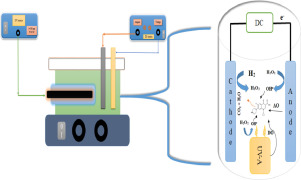当前位置:
X-MOL 学术
›
Microchem. J.
›
论文详情
Our official English website, www.x-mol.net, welcomes your
feedback! (Note: you will need to create a separate account there.)
Degradation of Ciprofloxacin Antibiotic Using Photo-Electrocatalyst Process of Ni-Doped ZnO Deposited by RF Sputtering on FTO as an Anode Electrode from Aquatic Environments: Synthesis, Kinetics, and Ecotoxicity Study
Microchemical Journal ( IF 4.9 ) Pub Date : 2020-05-01 , DOI: 10.1016/j.microc.2020.104663 Mehdi Hosseini , Ali Esrafili , Mahdi Farzadkia , Majid Kermani , Mitra Gholami
Microchemical Journal ( IF 4.9 ) Pub Date : 2020-05-01 , DOI: 10.1016/j.microc.2020.104663 Mehdi Hosseini , Ali Esrafili , Mahdi Farzadkia , Majid Kermani , Mitra Gholami

|
Abstract In the current study, a novel electrode comprising of Ni-doped ZnO on a fluorine-doped tin oxide (FTO) glass was successfully applied as a photo-anode electrode to degrade ciprofloxacin (CIP) in synthetic solutions under ultraviolet A (UV-A) irradiation. In the first step, Ni-doped ZnO, deposited on an FTO glass (the synthesized photoanode electrode), via a radio-frequency (RF) sputtering technique. Morphological and structural analyses of synthesized composites were performed utilizing X-ray diffraction (XRD), scanning electron microscopy (SEM), and energy-dispersive X-ray (EDX) techniques, while the optical assets were investigated by diffuse reflectance spectroscopy (DRS) technique. The effects of variables such as pH [3] , [4] , [5] , [6] , [7] , [8] , [9] , [10] , [11] , applied current (0.625–1.87 mA/cm2), initial concentration of CIP (5–50 mg/l), and reaction time (0–120 min) on CIP removal efficiency were investigated in a batch photo-reactor. Based on the results, suitable degradation of CIP (100%) was observed when the applied current was 1.87 mA/cm2, pH was 7, initial CIP concentration was 5 mg/L, and NaCl concentration as the electrolyte was 0.75 g/L after 90 min under UV-A (ƛ = 390 nm). The kinetic study was based on the first-order kinetics. Under optimal conditions, 83.7% of the initial total organic carbon (TOC) was removed. The application of electrolysis and photolysis processes led to a 2.04-fold synergistic effect in the CIP removal efficiency. Finally, the results showed that the photoelectrocatalysis process could significantly improve CIP degradation that could be used in the treatment of wastewater containing pharmaceutical compounds, such as CIP.
中文翻译:

环丙沙星抗生素使用光催化工艺在 FTO 上通过射频溅射沉积在 FTO 上作为阳极电极沉积的 Ni 掺杂 ZnO 的降解:合成、动力学和生态毒性研究
摘要 在目前的研究中,一种由掺氟氧化锡 (FTO) 玻璃上的 Ni 掺杂 ZnO 组成的新型电极被成功用作光阳极电极,以在紫外线 A (UV- A) 辐照。在第一步中,通过射频 (RF) 溅射技术,将 Ni 掺杂的 ZnO 沉积在 FTO 玻璃(合成光阳极电极)上。利用 X 射线衍射 (XRD)、扫描电子显微镜 (SEM) 和能量色散 X 射线 (EDX) 技术对合成复合材料进行形态和结构分析,同时通过漫反射光谱 (DRS) 研究光学资产技术。pH [3] , [4] , [5] , [6] , [7] , [8] , [9] , [10] , [11] 等变量的影响, 外加电流 (0.625–1.87 mA /cm2), 在间歇式光反应器中研究了 CIP 的初始浓度(5-50 毫克/升)和反应时间(0-120 分钟)对 CIP 去除效率的影响。结果表明,当外加电流为 1.87 mA/cm2,pH 为 7,初始 CIP 浓度为 5 mg/L,电解液 NaCl 浓度为 0.75 g/L 时,观察到 CIP 的适当降解(100%)。在 UV-A (ƛ = 390 nm) 下 90 分钟。动力学研究基于一级动力学。在最佳条件下,初始总有机碳 (TOC) 的 83.7% 被去除。电解和光解工艺的应用导致 CIP 去除效率的 2.04 倍协同效应。最后,
更新日期:2020-05-01
中文翻译:

环丙沙星抗生素使用光催化工艺在 FTO 上通过射频溅射沉积在 FTO 上作为阳极电极沉积的 Ni 掺杂 ZnO 的降解:合成、动力学和生态毒性研究
摘要 在目前的研究中,一种由掺氟氧化锡 (FTO) 玻璃上的 Ni 掺杂 ZnO 组成的新型电极被成功用作光阳极电极,以在紫外线 A (UV- A) 辐照。在第一步中,通过射频 (RF) 溅射技术,将 Ni 掺杂的 ZnO 沉积在 FTO 玻璃(合成光阳极电极)上。利用 X 射线衍射 (XRD)、扫描电子显微镜 (SEM) 和能量色散 X 射线 (EDX) 技术对合成复合材料进行形态和结构分析,同时通过漫反射光谱 (DRS) 研究光学资产技术。pH [3] , [4] , [5] , [6] , [7] , [8] , [9] , [10] , [11] 等变量的影响, 外加电流 (0.625–1.87 mA /cm2), 在间歇式光反应器中研究了 CIP 的初始浓度(5-50 毫克/升)和反应时间(0-120 分钟)对 CIP 去除效率的影响。结果表明,当外加电流为 1.87 mA/cm2,pH 为 7,初始 CIP 浓度为 5 mg/L,电解液 NaCl 浓度为 0.75 g/L 时,观察到 CIP 的适当降解(100%)。在 UV-A (ƛ = 390 nm) 下 90 分钟。动力学研究基于一级动力学。在最佳条件下,初始总有机碳 (TOC) 的 83.7% 被去除。电解和光解工艺的应用导致 CIP 去除效率的 2.04 倍协同效应。最后,











































 京公网安备 11010802027423号
京公网安备 11010802027423号